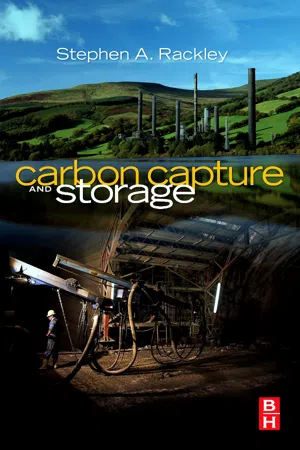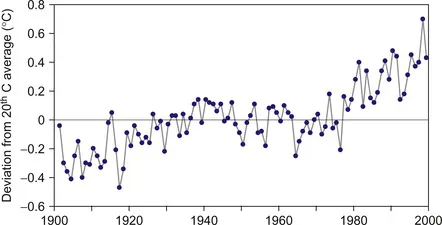
- 408 pages
- English
- ePUB (mobile friendly)
- Available on iOS & Android
eBook - ePub
Carbon Capture and Storage
About this book
Carbon dioxide capture and storage (CCS) is a technology aimed at reducing greenhouse gas emissions from burning fossil fuels during industrial and energy-related processes. CCS involves the capture, transport and long-term storage of carbon dioxide, usually in geological reservoirs deep underground that would otherwise be released to the atmosphere. Carbon dioxide capture and storage offers important possibilities for making further use of fossil fuels more compatible with climate change mitigation policies. The largest volumes of CO2 could be captured from large point sources such as from power generation, which alone accounts for about 40 per cent of total anthropogenic CO2 emissions. The development of capture technologies in the power generation sector could be particularly important in view of the projected increase in demand for electricity in fast developing countries with enormous coal reserves (IEA 2002a). Although, this prospect is promising, more research is needed to overcome several hurdles such as important costs of capture technology and the match of large capture sources with adequate geological storage sites. The book will provide a comprehensive, detailed but non-specialist overview of the wide range of technologies involved in carbon dioxide capture and sequestration.
- Focuses on technology rather than regulation and cost
- Covers both traditional and cutting edge capture technology
- Contains an abundance of case-studies an worked out examples
- Insight into CSS technical processes
Frequently asked questions
Yes, you can cancel anytime from the Subscription tab in your account settings on the Perlego website. Your subscription will stay active until the end of your current billing period. Learn how to cancel your subscription.
At the moment all of our mobile-responsive ePub books are available to download via the app. Most of our PDFs are also available to download and we're working on making the final remaining ones downloadable now. Learn more here.
Perlego offers two plans: Essential and Complete
- Essential is ideal for learners and professionals who enjoy exploring a wide range of subjects. Access the Essential Library with 800,000+ trusted titles and best-sellers across business, personal growth, and the humanities. Includes unlimited reading time and Standard Read Aloud voice.
- Complete: Perfect for advanced learners and researchers needing full, unrestricted access. Unlock 1.4M+ books across hundreds of subjects, including academic and specialized titles. The Complete Plan also includes advanced features like Premium Read Aloud and Research Assistant.
We are an online textbook subscription service, where you can get access to an entire online library for less than the price of a single book per month. With over 1 million books across 1000+ topics, we’ve got you covered! Learn more here.
Look out for the read-aloud symbol on your next book to see if you can listen to it. The read-aloud tool reads text aloud for you, highlighting the text as it is being read. You can pause it, speed it up and slow it down. Learn more here.
Yes! You can use the Perlego app on both iOS or Android devices to read anytime, anywhere — even offline. Perfect for commutes or when you’re on the go.
Please note we cannot support devices running on iOS 13 and Android 7 or earlier. Learn more about using the app.
Please note we cannot support devices running on iOS 13 and Android 7 or earlier. Learn more about using the app.
Yes, you can access Carbon Capture and Storage by Steve A. Rackley,Stephen A. Rackley in PDF and/or ePUB format, as well as other popular books in Technology & Engineering & Environmental Management. We have over one million books available in our catalogue for you to explore.
Information
Chapter 1. Introduction
The fossil fuel resources of our planet—estimated at between 4000 and 6000 gigatonnes of carbon (Gt-C)—are the product of biological and geologic processes that have occurred over hundreds of million of years and continue today. The carbon sequestered in these resources over geological time was originally a constituent of the atmosphere of a younger earth—an atmosphere that contained ∼1500 parts per million (ppm) CO2 at the beginning of the Carboniferous age, 360 million years ago, when the evolution of earth’s first primitive forests began the slow process of biogeological sequestration.
Since the dawn of the industrial age, circa 1750, and particularly since the invention of the internal combustion engine, ∼5% of these resource volumes have been combusted and an estimated 280Gt-C released back into the atmosphere in the form of CO2. In the same period a further ∼150Gt-C has been released to the atmosphere from soil carbon pools as a result of changes in land use. The atmospheric, terrestrial, and oceanic carbon cycles have dispersed the greater part of these anthropogenic emissions, locking the CO2 away by dissolution in the oceans and in long-lived carbon pools in soils. During the period since 1750, the CO2 concentration in the atmosphere has increased from 280ppm to 368ppm in 2000, and ∼388ppm in 2010, the highest level in the past 650,000 years and one that is not likely to have been exceeded in the past 20 million years, where “likely” reflects the Intergovernmental Panel on Climate Change (IPCC) judgment of a 66–90% chance.
This increase in atmospheric CO2 concentration ([CO2]) influences the balance of incoming and outgoing energy in the earth-atmosphere system, CO2 being the most significant anthropogenic greenhouse gas (GHG). In its Fourth Assessment Report (AR4), published in 2007, the IPCC concluded that global average surface temperatures had increased by 0.74 ± 0.18°C over the 20th century (Figure 1.1), and that “most of the observed increase in global average temperatures since the mid-20th century is very likely (>90% probability) due to the observed increase in anthropogenic GHG concentrations.”
 |
| Figure 1.1 Variation of the earth’s surface temperature during the 20th century (IPCC data) |
Although anthropogenic CO2 emissions are relatively small compared to the natural carbon fluxes—for example, photosynthetic and soil respiration fluxes, at ∼60Gt-C per year, are 10 times greater than current emissions from fossil fuel combustion—these anthropogenic releases have occurred on a time scale of hundreds rather than hundreds of millions of years. Anthropogenic change has also reduced the effectiveness of certain climate feedback mechanisms; for example, changes in land-use and land-management practices have reduced the ability of soils to build soil carbon inventory in response to higher atmospheric CO2, while ocean acidification has reduced the capacity of the oceans to take up additional CO2 from the atmosphere.
The energy consumption of modern economies continues to grow, with some scenarios predicting a doubling of global energy demand between 2010 and 2050. Fossil fuels currently satisfy 85% of global energy demand and fuel a similar proportion of global electricity generation, and their predominance in the global energy mix will continue well into the 21st century, perhaps much longer. In the absence of mitigation, the resulting emissions will lead to further increase in atmospheric [CO2], causing further warming and inducing many changes in global climate. Even if [CO2] is stabilized before 2100, the warming and other climate effects are expected to continue for centuries, due to the long time scales associated with climate processes. Climate predictions for a variety of stabilization scenarios suggest warming over a multicentury time scale in the range of 2°C to 9°C, with more recent results favoring the upper half of this range.
Although many uncertainties remain, there is little room for serious doubt that measures to reduce CO2 emissions are urgently required to minimize long-term climate change. While research and development efforts into low- or zero-carbon alternatives to the use of fossil fuels continues, the urgent need to move toward stabilization of [CO2] means that measures such as the capture and storage of carbon that would otherwise be emitted can play an important role during the period of transition to low-carbon alternatives.
Within the field of carbon capture and storage (CCS), a diverse range of technologies is currently under research and development and a growing number of demonstration projects have been started or are planned. A few technologies have already reached the deployment stage, where local conditions or project specifics have ...
Table of contents
- Cover image
- Table of Contents
- Copyright
- Preface
- Acknowledgements
- Chapter 1. Introduction
- Chapter 2. Overview of Carbon Capture and Storage
- Chapter 3. Power Generation Fundamentals
- Chapter 4. Carbon Capture from Power Generation
- Chapter 5. Carbon Capture from Industrial Processes
- Chapter 6. Absorption Capture Systems
- Chapter 7. Adsorption Capture Systems
- Chapter 8. Membrane Separation Systems
- Chapter 9. Cryogenic and Distillation Systems
- Chapter 10. Mineral Carbonation
- Chapter 11. Geological Storage
- Chapter 12. Ocean Storage
- Chapter 13. Storage in Terrestrial Ecosystems
- Chapter 14. Other Sequestration and Use Options
- Chapter 15. Carbon Dioxide Transportation
- Chapter 16. Further Sources of Information
- Chapter 17. Units, Acronyms, and Glossary
- Index